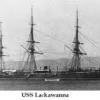MORE HANDBOOKS ARE ON THEIR WAY! We will let you know when they get here.
×
-
Posts
1,197 -
Joined
-
Last visited
Reputation Activity
-
 Stuntflyer got a reaction from PeteB in HM Cutter Cheerful 1806 by Stuntflyer (Mike) - FINISHED - 1:48 scale
Stuntflyer got a reaction from PeteB in HM Cutter Cheerful 1806 by Stuntflyer (Mike) - FINISHED - 1:48 scale
Planking the deck is not exactly what I would call a milestone though it does feel like I'm moving along. . .
Though not very scientific, I did come up with a way to get those center planks in a straight line. After setting the first plank at the stern I used a card template at each location along the deck to keep the planks straight. To confirm alignment, I marked the center of the plank at its forward edge as well as the aft edge of the deck structure. After pulling the plank to the card template I could see whether or not two marks matched closely
The four remaining planks (two on each side of center plank) where then installed using PVA and clamps. I was careful not to glue anywhere close to the red deck structures. Scrap strips were used between the clamp and the deck planking to avoid any dents that might be caused from tightening of the clamps. I don't have any of those high-tech wooden clamps like those used by EdT though the ones from Dewalt (found at Home Depot) worked well enough. The clamp's protective covers were removed in order to get a better grip on the planks. The Irwin Quick-Grips have a more rounded shape underneath the covers and tend to slip off too easily.
My deck planks are approximately 3/16" wide and in various locations will have a small tab. These have to be made using a wider strip. I tried making one that would have been 7/32" at its widest point using a 7/32" strip. Guess what, it didn't work. There wasn't enough room to allow for adjustments to the shape. I decided to go with a 1/4" strip, which worked quite well. Once the shape was completed it was only a matter of reducing the width to 3/16" outside of the tab location. This is an important step if you want to maintain consistency to the overall look of the planking.
This is the plank which goes on either side of the "ventilation scuttle grating", just behind the skylight.
Once the first five rows were completed, excess glue was removed and the planks were lightly sanded. I will hold off doing the final sanding until all of the remaining planks are in.
-
 Stuntflyer got a reaction from GuntherMT in HM Cutter Cheerful 1806 by Stuntflyer (Mike) - FINISHED - 1:48 scale
Stuntflyer got a reaction from GuntherMT in HM Cutter Cheerful 1806 by Stuntflyer (Mike) - FINISHED - 1:48 scale
Planking the deck is not exactly what I would call a milestone though it does feel like I'm moving along. . .
Though not very scientific, I did come up with a way to get those center planks in a straight line. After setting the first plank at the stern I used a card template at each location along the deck to keep the planks straight. To confirm alignment, I marked the center of the plank at its forward edge as well as the aft edge of the deck structure. After pulling the plank to the card template I could see whether or not two marks matched closely
The four remaining planks (two on each side of center plank) where then installed using PVA and clamps. I was careful not to glue anywhere close to the red deck structures. Scrap strips were used between the clamp and the deck planking to avoid any dents that might be caused from tightening of the clamps. I don't have any of those high-tech wooden clamps like those used by EdT though the ones from Dewalt (found at Home Depot) worked well enough. The clamp's protective covers were removed in order to get a better grip on the planks. The Irwin Quick-Grips have a more rounded shape underneath the covers and tend to slip off too easily.
My deck planks are approximately 3/16" wide and in various locations will have a small tab. These have to be made using a wider strip. I tried making one that would have been 7/32" at its widest point using a 7/32" strip. Guess what, it didn't work. There wasn't enough room to allow for adjustments to the shape. I decided to go with a 1/4" strip, which worked quite well. Once the shape was completed it was only a matter of reducing the width to 3/16" outside of the tab location. This is an important step if you want to maintain consistency to the overall look of the planking.
This is the plank which goes on either side of the "ventilation scuttle grating", just behind the skylight.
Once the first five rows were completed, excess glue was removed and the planks were lightly sanded. I will hold off doing the final sanding until all of the remaining planks are in.
-
 Stuntflyer reacted to rafine in Cutter Cheerful 1806 by rafine - FINISHED
Stuntflyer reacted to rafine in Cutter Cheerful 1806 by rafine - FINISHED
I've now completed the next segment of interior detailing. This included eyebolts at the foot of the mast, deck ringbolts, a couple of bulwark cleats, bulwark pin rails and belaying pins, the last two carronades, the galley stack and the mast bitts and winch.
The guns, cleats, ringbolts and eyebolts all followed the procedures previously described for them.
The pin rails were cut from boxwood strip, shaped and drilled for the pins, painted red and then pinned and glued to the bulwarks. The belaying pins are commercial brass items, which I blackened.
The galley stack was cut in four pieces from 1/32" boxwood sheet, assembled, painted black and installed on it's previously installed base.
The mast bitts and winch were a fun piece to do. The bitts were cut from boxwood strip and shaped with files. The cross piece was cut from strip, notched with saw and chisel cuts and mounted on the bitts. The knees were were cut from boxwood sheet and added to the bitts. The winch barrel was made from two sizes of dowel. The gears were an interesting exercise. I first tried, unsuccessfully, to do them from wood with a file. I finally ended up using styrene tube, which I filed lengthwise, and then cut slices to size and painted black. They are hardly perfect, but they are very small and their appearance is satisfactory to me. The handles or cranks are bent brass rod, blackened and passed through pieces of blackened brass tube to represent bearings.I tried to follow the drawings and the photos of the contemporary model, but I have no idea whether this mechanical arrangement is correct.
I'm now moving on to the last, forward segment.
Bob
-
 Stuntflyer reacted to Erik W in HM Cutter Cheerful 1806 by Erik W - 1:48 scale
Stuntflyer reacted to Erik W in HM Cutter Cheerful 1806 by Erik W - 1:48 scale
Mark, Chuck, Thanks! While I'm in no particular hurry, starting the fairing with 120 & 220 grit sanding sticks/blocks like I did seemed like an exercise in futility!
Erik
-
 Stuntflyer reacted to KenW in Rattlesnake by KenW - FINISHED - Model Shipways - Scale 1:64 - American Privateer
Stuntflyer reacted to KenW in Rattlesnake by KenW - FINISHED - Model Shipways - Scale 1:64 - American Privateer
Thanks Greg and Dan.
I'll plan out the location of the catheads while working on the head rails.
I'll be at the SMSNJ meeting on the 26th and hope to bring the model.
Cheers.
-
 Stuntflyer reacted to KenW in Rattlesnake by KenW - FINISHED - Model Shipways - Scale 1:64 - American Privateer
Stuntflyer reacted to KenW in Rattlesnake by KenW - FINISHED - Model Shipways - Scale 1:64 - American Privateer
I finally completed the cheeks and mounted them on the stem, along with the wolf-hounds. ‘Martin W’ was right – the wolf hounds were a bit too large. In fact, even though the carved wolfs were the exact size as those on the MS plans, the stem wasn’t the same size as the plans. So I had to make the cheeks narrower and modify the carvings in order to manage to fit them on the model. They don’t look as I imaged them, but I think they’re OK. The cheeks were laminated to get the look I wanted.
I also created small laminated pieces to enable the covering boards to look like they curved around at 180 degrees. I think the result looks pretty good.
Now I'll continue working on the head.
-
 Stuntflyer reacted to Mike Y in Beavers Prize 1777 by Mike Y - 1:48 - POF - Hahn style
Stuntflyer reacted to Mike Y in Beavers Prize 1777 by Mike Y - 1:48 - POF - Hahn style
Hoorray, gunports are done!
Practice is the key, the last ports were made twice faster than the first ones
I also changed the lights in the room and working table to a warmer ones, and now my camera switched to some sort of warm mode when in auto. Photos look weird now, need to find how to adjust the brightness settings on the camera...
The next step should be fun - hull fairing! Really worried I screwed up the frame alignment, and I added complexity when installed that "iron bolts" that hold the "timbers" together. Which gives a smaller margin for fairing - bolts can't become too close to the frame edge.
-
 Stuntflyer reacted to Erik W in HM Cutter Cheerful 1806 by Erik W - 1:48 scale
Stuntflyer reacted to Erik W in HM Cutter Cheerful 1806 by Erik W - 1:48 scale
I glued on all the bulkheads and filler blocks. These went in easily. The notches on both the bulkheads and the false keel are nice and deep, so aside from making sure the bulkheads are 90 degrees to the false keel using a square, the assembly is a no brainer. I included a shot of my recently finished longboat with the Cheerful hull to show the size comparison. I have to say, when I built the longboat, I thought it was big, compared to the 1/160 model railroad stuff I've spent most of my life working on, but the Cheerful is positively HUGE! Haha! I guess it's all relative . . .
Erik
-
 Stuntflyer reacted to Erik W in HM Cutter Cheerful 1806 by Erik W - 1:48 scale
Stuntflyer reacted to Erik W in HM Cutter Cheerful 1806 by Erik W - 1:48 scale
Chuck,
Yeah, from here on out I plan on taking it slow. I know I have the easy part done. I had accidentally over faired the longboat a bit, so I plan on approaching that and the planking more methodically than I did on the last build.
Erik
-
 Stuntflyer got a reaction from Archi in HM Cutter Cheerful 1806 by Stuntflyer (Mike) - FINISHED - 1:48 scale
Stuntflyer got a reaction from Archi in HM Cutter Cheerful 1806 by Stuntflyer (Mike) - FINISHED - 1:48 scale
Here's wishing you all a very Happy New Year!
While waiting for boxwood sheet needed for deck planking, I was able to complete a few small projects. Those being the shaping the channels, backstay plates (unpainted), jib outhaul block and scuppers.
The channels and backstay plates were made as described in Chuck's log.
This was my build sequence to complete the outhaul block. .
Step 1. 1/16" strip was cut to the overall size of the block. Holes were measured and drilled for the treenails (#76) and center pin (.028"). Drilling incorrectly at this stage seemed far better than doing so after the whole thing was assembled and shaped.
Step 2. Used as a guide a short length of 22 gauge wire was inserted through the center hole. A 5/32" dowel center drilled and sliced to 3/64" was placed over the wire. The dowel was then secured to the strip.
Steps 3-4. 3/64" strip was glued to the 1/16" strip with a .024 pin used as a spacer. This allows the .018 rigging rope to pass through the block.
Steps 5-8. The overhanging 3/64" strips are trimmed off and the block is shaped. Once completed the treenails are simulated and 22 gauge wire is inserted through the center hole, standing proud slightly. The back of the wire is filed flush.
-
 Stuntflyer got a reaction from mtaylor in HM Cutter Cheerful 1806 by Erik W - 1:48 scale
Stuntflyer got a reaction from mtaylor in HM Cutter Cheerful 1806 by Erik W - 1:48 scale
Hello Erik,
Great start! I know that this is going to be a wonderful build for you as well as for all of us watching.
Have fun,
Mike
-
 Stuntflyer reacted to Erik W in HM Cutter Cheerful 1806 by Erik W - 1:48 scale
Stuntflyer reacted to Erik W in HM Cutter Cheerful 1806 by Erik W - 1:48 scale
This week has been spent getting the keel put together and glued on straight and true. The laser cut keel parts fit together well, with minimal cleanup. I followed the instructions for the tree nails, using a pencil to darken the hole and then using Natural color Elmer's Wood Filler. The tree nails look faint in the photos, but are more visible in person. Once everything was glued together I sanded the keel smooth with 220, 320, and then 400 grit sandpaper and rubbed in Wipe-on-Poly (satin) for about 30 seconds, then immediately wiped it off. I'm enjoying this Castello boxwood! I like working with a small grain hardwood. It's refreshing after the fuzzy basswood I'm used to.
Erik
-
 Stuntflyer got a reaction from Canute in HM Cutter Cheerful 1806 by Erik W - 1:48 scale
Stuntflyer got a reaction from Canute in HM Cutter Cheerful 1806 by Erik W - 1:48 scale
Hello Erik,
Great start! I know that this is going to be a wonderful build for you as well as for all of us watching.
Have fun,
Mike
-
 Stuntflyer got a reaction from Erik W in HM Cutter Cheerful 1806 by Erik W - 1:48 scale
Stuntflyer got a reaction from Erik W in HM Cutter Cheerful 1806 by Erik W - 1:48 scale
Hello Erik,
Great start! I know that this is going to be a wonderful build for you as well as for all of us watching.
Have fun,
Mike
-
 Stuntflyer reacted to Erik W in HM Cutter Cheerful 1806 by Erik W - 1:48 scale
Stuntflyer reacted to Erik W in HM Cutter Cheerful 1806 by Erik W - 1:48 scale
Humble beginnings. I glued the two halves of the false keel together. The plywood is perfectly flat and straight, so the false keel is absolutely straight. I added some scrap strip wood for reinforcement along the joint. I then glued on the 1/8" x 1/16" rabbet strip along the length of the bottom. I drew the bearding line on the starboard side of the false keel to match the line on the port side. I'll tweak it a bit before I start removing material. I also marked each slot, both sides, where the number/lettered bulkheads will go.
I threw in a penny and pencil to give an indication of size.
Erik
-
 Stuntflyer reacted to Erik W in HM Cutter Cheerful 1806 by Erik W - 1:48 scale
Stuntflyer reacted to Erik W in HM Cutter Cheerful 1806 by Erik W - 1:48 scale
Mike, Y
Yes! I know sailors are a superstitious group, so I can see how that would extend to those of us that build ships. The White Towel might be the secret! One great thing about jumping into the Cheerful build now is that I can learn from other's endeavors. Between that and The White Towel, I'll be unstoppable!
I'm glad to have other folks following my build. It helps me motivate!
Erik
-
 Stuntflyer reacted to Mike Y in HM Cutter Cheerful 1806 by Erik W - 1:48 scale
Stuntflyer reacted to Mike Y in HM Cutter Cheerful 1806 by Erik W - 1:48 scale
Do not forget The White Towel to make a photos of the model for the log!
Heard it brings luck, +3% to the accuracy, -20% chance of measurement mistakes
P.S: watching with envy, it is such a joy to have a build buddies building the same ship in parallel!
-
 Stuntflyer reacted to Erik W in Young America 1853 by EdT - FINISHED - extreme clipper
Stuntflyer reacted to Erik W in Young America 1853 by EdT - FINISHED - extreme clipper
Ed,
I've been following this build closely, and reading through both of your Young American build logs. You're doing superb work. It's a testament to your enthusiasm for this project, your writing style, and you photographing every step, that someone like me, who always was interested exclusively in naval subjects, now has an interest in clipper ships!
Do you plan on rigging both of these?
Erik
-
 Stuntflyer reacted to EdT in Heroine 1838 by ggrieco - FINISHED - Scale 1:24 - Western River Steamboat as she appeared before hitting a snag in the Red River
Stuntflyer reacted to EdT in Heroine 1838 by ggrieco - FINISHED - Scale 1:24 - Western River Steamboat as she appeared before hitting a snag in the Red River
Glenn, your modeling of the machinery is extraordinary. My hat - and I'm sure many other hats - is off to you. You did not mention cleaning and pickling in describing your blackening process, but it is clear from the results that you are doing a great job with that as well as the blackening process itself. The steps you mention make a lot of sense to me and I have done similar things with success. Trouble is, I often take short cuts that impair results and have not had the discipline to note what works well and consistently follow that process. Great job - and a very interesting project.
Ed
-
 Stuntflyer got a reaction from Archi in HM Cutter Cheerful 1806 by Stuntflyer (Mike) - FINISHED - 1:48 scale
Stuntflyer got a reaction from Archi in HM Cutter Cheerful 1806 by Stuntflyer (Mike) - FINISHED - 1:48 scale
Erik, druxey, thank you for the nice comments and for all the "Likes".
With the waterway completed I was finally able to add a few of the deck structures. These were all done a while back as a diversion, that kept me from getting crazy, when I was re-doing the planking. The photo below shows how I was able to set the structures with the correct spacing and parallel. You can't see it here but there is a lower deck below the skylight. The skylight windows have been antiqued thus reducing reflections, though quite subtle when viewed in person.
-
 Stuntflyer got a reaction from PeteB in HM Cutter Cheerful 1806 by Stuntflyer (Mike) - FINISHED - 1:48 scale
Stuntflyer got a reaction from PeteB in HM Cutter Cheerful 1806 by Stuntflyer (Mike) - FINISHED - 1:48 scale
Here's wishing you all a very Happy New Year!
While waiting for boxwood sheet needed for deck planking, I was able to complete a few small projects. Those being the shaping the channels, backstay plates (unpainted), jib outhaul block and scuppers.
The channels and backstay plates were made as described in Chuck's log.
This was my build sequence to complete the outhaul block. .
Step 1. 1/16" strip was cut to the overall size of the block. Holes were measured and drilled for the treenails (#76) and center pin (.028"). Drilling incorrectly at this stage seemed far better than doing so after the whole thing was assembled and shaped.
Step 2. Used as a guide a short length of 22 gauge wire was inserted through the center hole. A 5/32" dowel center drilled and sliced to 3/64" was placed over the wire. The dowel was then secured to the strip.
Steps 3-4. 3/64" strip was glued to the 1/16" strip with a .024 pin used as a spacer. This allows the .018 rigging rope to pass through the block.
Steps 5-8. The overhanging 3/64" strips are trimmed off and the block is shaped. Once completed the treenails are simulated and 22 gauge wire is inserted through the center hole, standing proud slightly. The back of the wire is filed flush.
-
 Stuntflyer reacted to Mike Y in HMS Kingfisher 1770 by Remcohe - 1/48 - English 14-Gun Sloop - POF
Stuntflyer reacted to Mike Y in HMS Kingfisher 1770 by Remcohe - 1/48 - English 14-Gun Sloop - POF
Remco, you are also a master of inspiration - for example, that build log was a tipping point for me to start a fully framed model
Please keep up the great build! Somebody need to set the bar for the accuracy and quality
-
 Stuntflyer reacted to rafine in Cutter Cheerful 1806 by rafine - FINISHED
Stuntflyer reacted to rafine in Cutter Cheerful 1806 by rafine - FINISHED
Thanks so much Mike, Erik, druxey, Nils and Grant for the kind words and comments and thanks also to the "likes".
Mike, I put a small drill bit in a vise, butt end up, and wrap wire around it, then snip it off and pinch with a tweezer. I must fess up that I have been known to resort to ready mades from Model Expo when I tire of making them, particularly the very small ones.
Erik, I am using the .035 line for the breeching ropes.
Druxey, I'm not familiar with watchmaker's tweezers, but I'll look into them.
Bob
-
 Stuntflyer got a reaction from Canute in Cutter Cheerful 1806 by rafine - FINISHED
Stuntflyer got a reaction from Canute in Cutter Cheerful 1806 by rafine - FINISHED
Hello Bob,
I would be interested in knowing your method for making the eyebolts.
Mike
-
 Stuntflyer got a reaction from GLakie in Cutter Cheerful 1806 by rafine - FINISHED
Stuntflyer got a reaction from GLakie in Cutter Cheerful 1806 by rafine - FINISHED
Hello Bob,
I would be interested in knowing your method for making the eyebolts.
Mike








